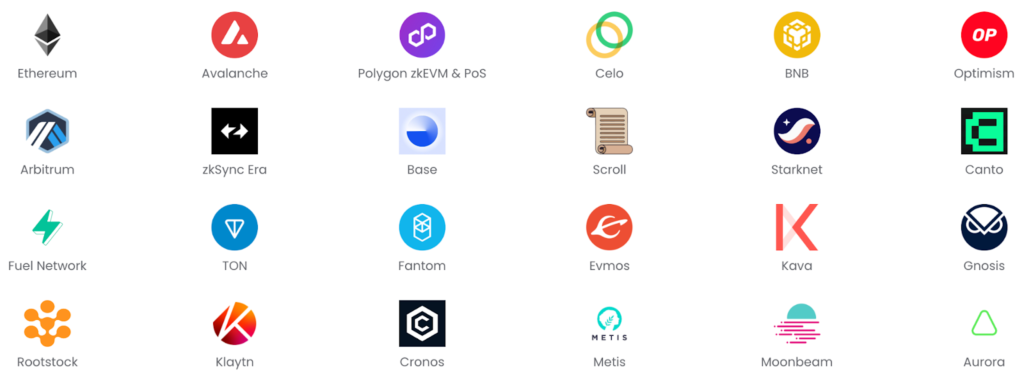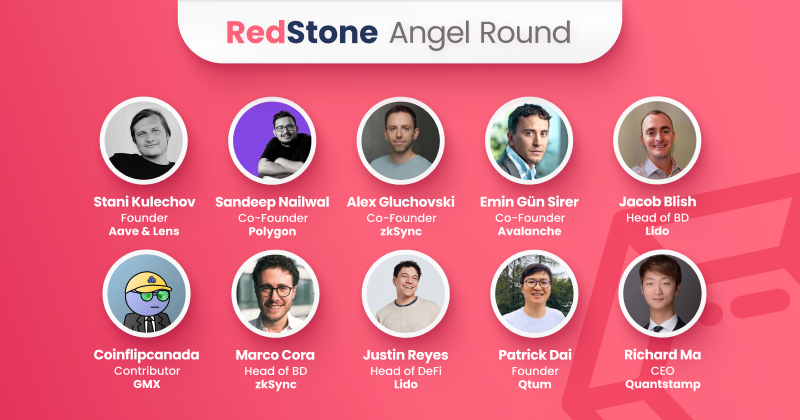Web3 pioneers including Stani Kulechov, Sandeep Nailwal, Alex Gluchovski, Emin Gün Sirer lead RedStone’s Exclusive Angel Round. RedStone disrupts the status quo in the oracle space with a modular design, data feeds customizability and presence at all EVM L1 & L2 networks. Angel participation from recognized industry leaders shows conviction that dApps require multiple oracle options to choose from and a single provider is simply not enough.
RedStone is Cross-chain by Design, Catering to Builders
RedStone was founded in 2021 and launched its first production deployments in January 2023. The company raised $7.5 Million in funding from some of the most renowned VCs in the space, including Lemniscap, Blockchain Capital, Maven11 and Coinbase Ventures. RedStone’s modular architecture is going to be a catalyst for the next wave of dApps by providing them with relevant data at low latency. Some of the most titled builders in the Web3 scene participate in this round, including:
- Stani Kulechov – Aave Companies Founder and CEO
- Sandeep Nailwal – Polygon Co-Founder
- Alex Gluchovski – Matter Labs (zkSync) CEO & Co-Founder
- Emin Gün Sirer – AvaLabs (Avalanche) CEO & Co-Founder
- Coinflipcanada – GMX Core Contributor
- Jacob Blish – Lido Head of BD and Partnerships
- Richard Ma – Quantstamp CEO
- Marco Cora – Matter Labs (zkSync) SVP Business and Operations
- Patrick Dai – Qtum Founder
- Justin Reyes - Lido Head of DeFi
“RedStone has created a unique, modular oracle that supports both new and established dApps on L1 and L2 networks. Combined with strong security measures and their ability to deliver non-standard data, RedStone is poised to provide choice and flexibility for the industry,”
said Stani Kulechov, Aave Companies Founder and CEO.
The Oracle Landscape in 2023 and Beyond
The oracle market has been stagnant for years, which hinders innovation. Since the publication of Chainlink’s whitepaper in 2017 not much has changed in the way oracles function. At the same time, the Web3 industry went through a few enhancement epochs with the emergence of DeFi, Ethereum upgrades, the LPs and LSTs boom. Currently, Optimistic & ZK roll-ups are thriving and modular architecture has captured wide attention. The latter trend is a crucial dynamic for the future adoption of RedStone’s Oracles.
RedStone embraces modular flow and is the same for the oracle space, what L2s are for blockchains – a customizable data scalability layer that inherits the security of the destination chain.
By keeping signed data packages in the RedStone Data Access Layer and delivering them according to conditions set by dApps, gas costs can be reduced by up to 90% while achieving sub-second price feed latency on high-performance ecosystems. RedStone Data Access Layer is flexible, catering to DeFi builders and offers data feeds that are unique and otherwise unavailable in the industry. Moreover, RedStone does not waste gas to push the same data to multiple chains.
RedStone’s unique position is an implication of the strain an oracle encounters, when moving from a monolithic to a modular architecture. Barriers include technical debt, agreements with clients and data providers, or security risks of changing the legacy design. RedStone was designed with built-in modularity, allowing for quick response to market trends. The team had to overcome numerous technical challenges and gas optimisation problems to enable secure and the most performant data consumption models.
Protocols and builders start to realise that Redstone offers secure and innovative alternative for the existing oracles. RedStone has been promoting the On-Demand approach for the past 2 years and is ready to be used on over 40 different L1s and L2s, having a head start over competitors in that space.
“To create innovative protocols, we can’t keep on using the same concepts from the 2020 DeFi summer. The way oracles work has not evolved much in the past years, which stifles growth. We need quick responses to market trends, an architecture compatible with zk-powered L2s and optimization in gas costs – that’s what RedStone Oracles brings to the table,”
said Sandeep Nailwal, Polygon Co-Founder.
What Differentiates RedStone From Competitors?
RedStone’s Modular architecture allows for offering data feeds not available with any of its competitors and enables tailored data consumption models. Customizability has been an unanswered need from other oracle providers, yet it’s the cornerstone for novel implementations. Builders need more freedom in parameters such as:
- Data aggregation mechanisms (for both off- and on-chain aggregation),
- Heartbeat and deviation threshold adjusted for specific dApp,
- Flow of data on-chain injection (pull vs push vs new ones),
- Custom flows of liquidation/opening a position.
Besides, a major differentiation is that with RedStone the protocol has full clarity and transparency in terms of data sources and origins of consumed price feeds – as opposed to the black box offered by other major players on the market. Finally, all delivered data is verified on-chain, therefore the integrity of price feeds is as secure as the consensus model of the target chain.
“Along the way we had to solve countless tech challenges such as Assembly-level optimisation of costs, so we are confident that our implementation is the most technologically advanced on-demand oracle model. Moreover, we give dApps creators a spectrum of customisation options regarding off-chain and on-chain aggregation methods, as well as an option to pick Data Providers they trust.”,
said Jakub Wojciechowski, RedStone CEO & Founder.

RedStone is ready to use on 40+ L1s & L2s, above major supported ecosystems.
The end of “One Oracle Model Fits It All”
RedStone’s mission is to allow builders to create exactly what they have envisioned. Therefore protocols can consume RedStone’s data in 3 models depending on the business use case:
- Core model (On-Demand): data is dynamically injected into users’ transactions call-data, achieving maximum gas efficiency and great user experience as the whole process fits into a single transaction.
Example: DeltaPrime was one of the quickest growing dApp in February 2023 thanks to unique feeds, such as GLP or stAvax, delivered by RedStone
- Classic model (Push): data is pushed into on-chain storage via decentralized and permissionless relayers. Protocols designed for the traditional Oracles interface can finally specify heartbeat, deviation threshold and trusted Data Providers.
Example: Mento uses this model on Celo and soon on other networks (case study).
- X model (No Front-running): targeting the needs of the most advanced DeFi protocols like perpetuals or options, by eliminating the front-running risk.
Example: Cadence Protocol implements model X on Canto.
“Creative startups who come and challenge incumbents are very important as they boost growth and ecosystem vibrancy. In the coming months, we will see innovative DeFi protocols powered by RedStone models launching on major networks such as zkSync Era,” said Alex Gluchovski, Matter Labs (zkSync) CEO & Founder.
What’s next for RedStone?
The company stays in a close feedback loop with top DeFi protocols, designing new features and maintaining strict security standards – the single most important factor in the oracle business. RedStone expands beyond EVM environments with the data feeds available on Starkent and Fuel Network and currently works on TON implementation.
About RedStone
RedStone is revolutionizing the oracles industry by implementing novel modular design and 3 tailor-made data consumption models. You can build the new generation of DeFi & Web3 protocols based on RedStone’s versatile data offering of Blue Chip, Long-Tail, LP, Ecosystem-native Tokens, as well as Real World Data and custom feeds.
